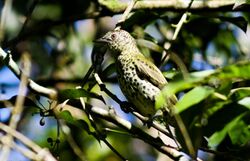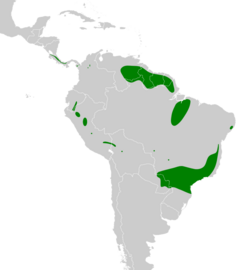Biology:Sharpbill
| Sharpbill | |
|---|---|

| |
| Scientific classification | |
| Domain: | Eukaryota |
| Kingdom: | Animalia |
| Phylum: | Chordata |
| Class: | Aves |
| Order: | Passeriformes |
| Family: | Tityridae |
| Genus: | Oxyruncus Temminck, 1820 |
| Species: | O. cristatus
|
| Binomial name | |
| Oxyruncus cristatus Swainson, 1821
| |

| |
The sharpbill (Oxyruncus cristatus) is a small passerine bird in the family Tityridae. Its range is from the mountainous areas of tropical South America and southern Central America (Panama and Costa Rica).
It inhabits the canopy of wet forest and feeds on fruit and some invertebrates. It has an orange erectile crest, black-spotted yellowish underparts and scaling on the head and neck. As its name implies, it has a straight, pointed beak, which gives its common name.
Sharpbills are most commonly found in tall dense forests but occasionally venture to the forest edge. Their diet consists of primarily of fruit, but they will also take insects, hanging upside down in from twigs to obtain insect larvae. They will also travel in mixed-species feeding flocks with ovenbirds, tanagers, woodpeckers and cotingas. The breeding system employed by this species is polygamous with closely grouped males displaying in from a lek.[2] The nest of the sharpbill is built by the female and is a small cup built on a slender branch. Chicks are fed by regurgitation.
The genus Oxyruncus was erected by the Dutch zoologist Coenraad Jacob Temminck in 1820.[3] The sharpbill was described in 1821 by the English naturalist William John Swainson under the binomial name Oxyrhuncus cristatus with an "h" inserted into the name of the genus.[4][5] The word Oxyruncus is from the Ancient Greek oxus for "sharp" or "pointed" and rhunkhos "bill". The specific epithet is from the Latin cristatus for "crested" or "plumed".[6]
Molecular phylogenetic studies have shown that the sharpbill occupies a basal position in a clade containing the Tityridae.[7][8][9][10] The sharpbill is sometimes placed in its own family Oxyruncidae.[10][11]
There are four subspecies:[12]
- Oxyruncus cristatus frater (Sclater, PL & Salvin, 1868) – Costa Rica and west Panama
- Oxyruncus cristatus brooksi Bangs & Barbour, 1922 – east Panama
- Oxyruncus cristatus hypoglaucus (Salvin & Godman, 1883) – southeast Venezuela, the Guianas and north Brazil
- Oxyruncus cristatus cristatus Swainson, 1821 – southeast Brazil, east Paraguay and northeast Argentina
References
- ↑ BirdLife International (2016). "Oxyruncus cristatus". IUCN Red List of Threatened Species 2016: e.T22700982A93807719. doi:10.2305/IUCN.UK.2016-3.RLTS.T22700982A93807719.en. https://www.iucnredlist.org/species/22700982/93807719. Retrieved 12 November 2021.
- ↑ Stiles, F. Gary; Whitney, Bret (1983). "Notes on the behavior of the Costa Rican Sharpbill (Oxyruncus cristatus frater)". Auk 100 (1): 117–125. doi:10.1093/auk/100.1.117. https://sora.unm.edu/sites/default/files/journals/auk/v100n01/p0117-p0125.pdf.
- ↑ Temminck, Coenraad Jacob (in French). Manuel d'ornithologie, ou, Tableau systématique des oiseaux qui se trouvent en Europe. Part 1 (2nd ed.). Paris: H. Cousin. p. 80 (LXXX). https://biodiversitylibrary.org/page/41001529.
- ↑ Swainson, William John (1821). Zoological illustrations, or, Original figures and descriptions of new, rare, or interesting animals. 1. London: Baldwin, Cradock, and Joy; and W. Wood. Plate 49 text. https://biodiversitylibrary.org/page/29156672.
- ↑ Traylor, Melvin A. Jr, ed (1979). Check-list of Birds of the World. 8. Cambridge, Massachusetts: Museum of Comparative Zoology. pp. 308–309. https://biodiversitylibrary.org/page/14501085.
- ↑ Jobling, James A. (2010). The Helm Dictionary of Scientific Bird Names. London: Christopher Helm. pp. 121, 287. ISBN 978-1-4081-2501-4. https://archive.org/details/Helm_Dictionary_of_Scientific_Bird_Names_by_James_A._Jobling.
- ↑ Ericson, P.G.P.; Zuccon, D.; Johansson, U.S.; Alvarenga, H.; Prum, R.O. (2006). "Higher-level phylogeny and morphological evolution of tyrant flycatchers, cotingas, manakins, and their allies (Aves: Tyrannida)". Molecular Phylogenetics and Evolution 40 (2): 471–483. doi:10.1016/j.ympev.2006.03.031. PMID 16678446.
- ↑ Ohlson, J.; Fjeldså, J.; Ericson, P.G.P. (2008). "Tyrant flycatchers coming out in the open: phylogeny and ecological radiation of Tyrannidae (Aves, Passeriformes)". Zoologica Scripta 37 (3): 315–335. doi:10.1111/j.1463-6409.2008.00325.x.
- ↑ Tello, J.G.; Moyle, R.G.; Marchese, D.J.; Cracraft, J. (2009). "Phylogeny and phylogenetic classification of the tyrant flycatchers, cotingas, manakins, and their allies (Aves: Tyrannides)". Cladistics 25 (5): 429–467. doi:10.1111/j.1096-0031.2009.00254.x.
- ↑ 10.0 10.1 Ohlson, J.I.; Irestedt, M.; Ericson, P.G.P.; Fjeldså, J. (2013). "Phylogeny and classification of the New World suboscines (Aves, Passeriformes)". Zootaxa 3613 (1): 1–35. doi:10.11646/zootaxa.3613.1.1. PMID 24698900. https://www.researchgate.net/publication/261371295.
- ↑ The Howard & Moore Complete Checklist of the Birds of the World. 2: Passerines (4th ed.). Eastbourne, UK: Aves Press. 2014. p. 17. ISBN 978-0-9568611-2-2.
- ↑ Gill, Frank; Donsker, David, eds (2017). "Tyrant flycatchers". World Bird List Version 7.3. International Ornithologists' Union. http://www.worldbirdnames.org/bow/flycatchers/.
- Charles G. Sibley; Scott M. Lanyon; Jon E. Ahlquist (1984) "The relationships of the Sharpbill (Oxyruncus cristatus)" Condor 86(1) 48–52.
External links
Wikidata ☰ {{{from}}} entry
 |


